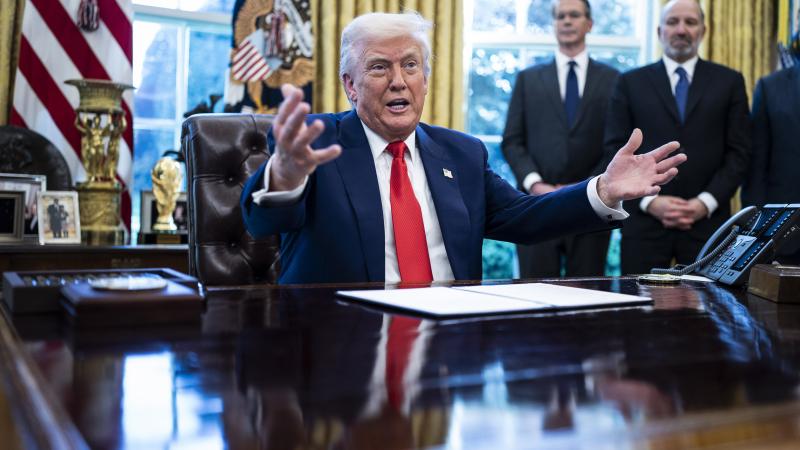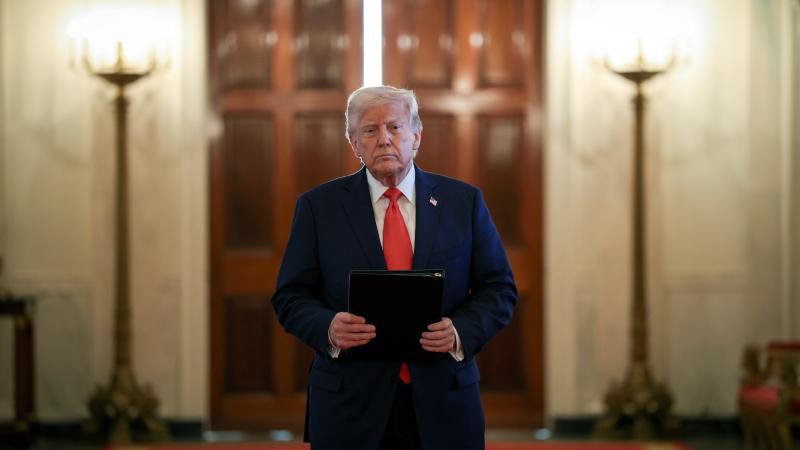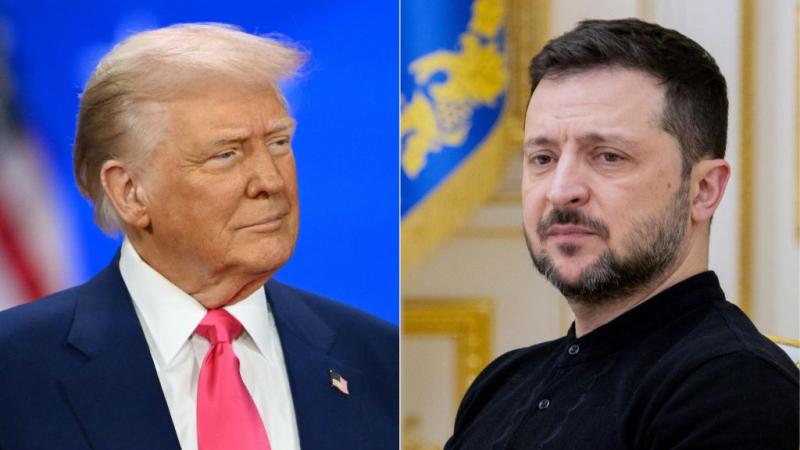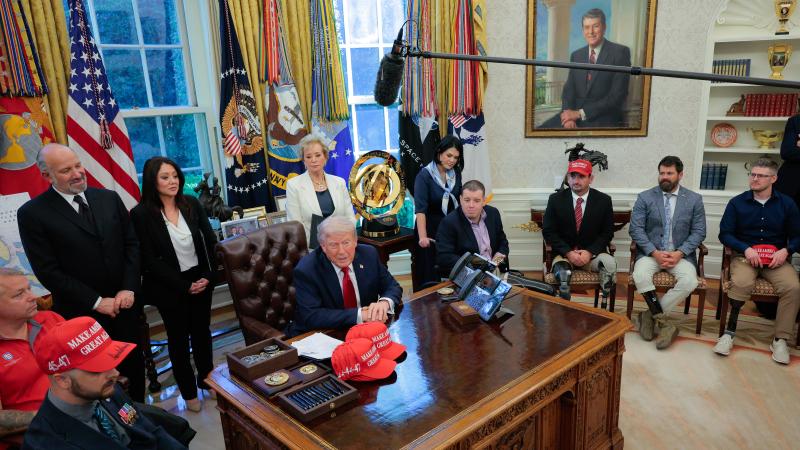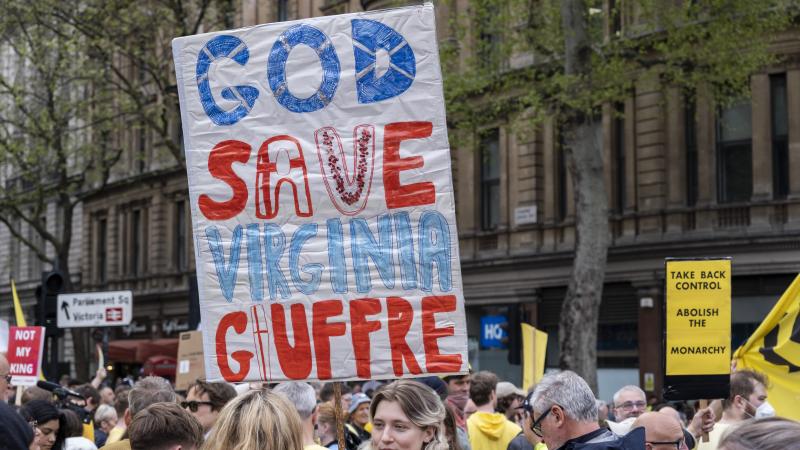Reagan secured peace through strength, Trump is betting he can achieve prosperity the same way
Trump's "Liberation Day" announcement in the Rose Garden was a declaration that the era of free trade and globalization was giving way to a new era of fair trade.
What happened in the White House Rose Garden on Wednesday afternoon can’t be underestimated, an undeniable shot heard throughout the world of global trade. President Donald Trump imposed a nearly universal 10% tax on most foreign products entering the United States, and in so doing ended the era of free trade.
The legacy of Trump’s gamble won’t be written in the first few weeks after the imposition of these new and historic tariffs – though legacy news media will try to gauge it through the certain volatility of investment markets in the next few weeks.
Rather, the verdict will be cemented by the answers to three questions that should clearly be answered by the time the 47th president leaves office in 2028:
- Will tariffs force allies and foes to drop their protectionism and treat U.S. products more fairly?
- Will they generate tens of trillions of dollars in new investment from companies seeking to escape the pain of tariffs by moving manufacturing and jobs back to America?
- And will those who keep unfair trade barriers to America generate enough new tax revenue to balance America’s budget and reduce the national debt?
In his announcement Wednesday afternoon, Trump made clear he had no qualms ending the era of free trade and replacing it with an era of fair trade – fair to America that is.
"Now it's our turn to prosper, and in so doing, use trillions and trillions of dollars to reduce our taxes and pay down our national debt," Trump declared.
Trump’s gambit closely mirrors Ronald Reagan’s bet on national security a half century ago when the 40th president used a military buildup and assertive foreign policy to economically and politically bankrupt the Soviet Union and end the Cold War.
That strategy became known as “peace through strength.” Trump’s plan – validated in advance by the Americans who voted for him in November, knowing he would impose tariffs – aims to prove that prosperity can be achieved through similar aggression, toughness and strength.
"What we are seeing here is Trump, the negotiator-in-chief that we've all come to know and love, is finally tackling decades and decades of countries who are willing to take our money but not our goods," Heritage Foundation expert Richard Stern told the Just the News, No Noise television show.
"And so we're finally holding them accountable and saying, look, what we want is freer and fairer trade. This is what's required to get there, drop your own trade barriers and actually play ball," he added.
Almost immediately, there were signs of early wins. More than $3 trillion in new projects and investment were secured inside the United States from foreign companies agreeing to move operations to America to free themselves from the tariffs. Trump predicted it would reach $5 trillion by his 100th day in office in April. Household names like Honda, Hyundai, Soft Bank and Taiwan Semiconductor were among the first to acquiesce.
Hours before Trump’s imposition, two American allies who have pursued protectionist policies that punish American exports immediately dropped or lowered their tariffs. The moves by Israel and Vietnam were surprising even to economists.
Canada sounded a month ago like it was ready to engage in a reciprocal trade war. But on Wednesday, its prime minister acknowledged his country would be harmed by such a battle with America and already signaled along with other leaders they’d like to reach a deal. Mexico also announced it didn’t plan retaliatory tariffs.
Those early signs, however, can’t hide a short-term difficult road. Trump admits some prices could go up, while others worry the big dog on the bloc – China – could escalate to a full trade war. Four GOP senators joined with Democrats Wednesday night to pass a bill rebuking Trump on Canadian tariffs. And markets will sour on the tariffs short term until reasons otherwise – like declining inflation – emerge.
Rep. Marlin Stutzman, R-Ind., predicted Wednesday night that middle America voters will stick with Trump short term even if prices go up temporarily because they understand the harm three decades of growing trade imbalances have had at their own kitchen table.
"It's not about raising prices. It's actually about supporting the American farmer and the American producer to actually have a level playing field," he told Just the News.
Trump’s next mission will be to relentlessly educate the public on what “free trade” did to America.
Free trade was a globalist dream cemented during Bill Clinton’s presidency with the NAFTA deal and conducted for more than two decades under Republican and Democrat presidents alike. And in fairness, free trade was just that – for most of the rest of world who wanted to access America’s lucrative markets.
But for the world’s most free and open market, it proved to be anything but. The free trade agreements of the 1990s and early 2000s unleashed an era of outsourcing, offshoring and record trade imbalances that grew astronomically and with grave consequence for America’s working and middle classes who found free trade to be personally unfair to their bottom lines.
The political elitists and economic 1-percenters who championed the free trade mantra reveled in the wealth they could achieve and did not feel much pain in the experiment they unleashed, until the COVID-19 pandemic exposed the horror of the world’s economic superpower being unable to secure medicines and medical supplies like masks and ventilators that used to be a staple of the U.S. health care system.
What ensued was a classic Washington response: there were investigations and hearings and much handwringing. But such lip service only deflected from the harsh reality that America’s trade deficit exploded even more dramatically under Joe Biden’s presidency, alongside inflation.
For the first time, the U.S. trade deficit on goods reached $1.2 trillion and on goods and services it topped more than $900 billion. The biggest beneficiary was America’s most vexing adversary, China, at $295.4 billion. The next four beneficiaries were supposed allies: the European Union, Mexico, Vietnam and Ireland.
Remarkably, when the era of free trade was launched with the NAFTA deal in 1994, America’s total goods and services deficit was just $166.6 billion. Three decades later it had ballooned nearly 10 times larger. China’s beneficial trade surplus with America in 2024 was nearly double the entire trade gap the day Clinton got NAFTA elected.
Trump is betting while everyday Americans might not know those numbers, they have felt the impact of the era in real wages and prosperity. That is why he was unapologetic Wednesday, making clear his economic strike wasn’t designed to appease allies or adversaries abroad or globalist elites at home, but rather to reverse a three-decade decline for everyday workers in the American marketplace.
"American steel workers, auto workers, farmers and skilled craftsmen, we have a lot of them here with us today. They really suffered, gravely,” he noted in the Rose Garden. “They watched in anguish as foreign leaders have stolen our jobs, foreign cheaters have ransacked our factories, and foreign scavengers have torn apart our once-beautiful American dream.
“With today's action, we are finally going to be able to make America great again, greater than ever before,” he added. “Jobs and factories will come roaring back into our country, and you see it happening already. We will supercharge our domestic industrial base.”

